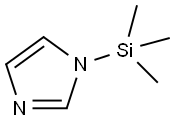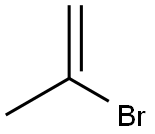(2-BROMOALLYL)TRIMETHYLSILANE
Synonym(s):2-Bromo-3-(trimethylsilyl)propene
- CAS NO.:81790-10-5
- Empirical Formula: C6H13BrSi
- Molecular Weight: 193.16
- MDL number: MFCD00043054
- SAFETY DATA SHEET (SDS)
- Update Date: 2023-06-08 17:06:38

What is (2-BROMOALLYL)TRIMETHYLSILANE?
Physical properties
bp 46–50°C/20 mmHg,64–65°C/38– 39 mmHg.
The Uses of (2-BROMOALLYL)TRIMETHYLSILANE
2-Bromo-3-trimethylsilyl-1-propene can be used as synthon for CH2=C?CH2TMS1–3 and CH2=CBrC?H2;2 for
synthesis of 1-trimethylsilylmethyl-substituted 1,3-butadienes.
The 1-trimethylsilylmethylvinyl
anion CH2=C(M)CH2TMS (2) (M = Li, Mg, Cu,
etc.), readily prepared from 2-bromo-3-trimethylsilyl-1-propene
(1) under typical conditions, allows the introduction of the
synthetically useful 1-trimethylsilylmethylvinyl group to a wide
variety of substrates. Ring opening of 1-butene oxide with the
Grignard reagent (2) (M = MgBr) in the presence of copper(I)
iodide gives only one regioisomer. Subsequent desilylative oxidation
of this allyl alcohol to α-methylene-γ-lactones provides
further utility of (1) as a 1-hydroxymethylvinyl anion equivalent,
i.e. CH2=?C?CH2OH (eq 1).Alternatively, the alcohol
from trans-2,3-epoxybutane provides a route to the unstable sixmembered
β,γ-unsaturated lactone (eq 2).The copper-catalyzed
1,4-addition to the typically unreactive mesityl oxide proceeds
smoothly. The versatility of the allylsilane moiety is again illustrated
in the ethylaluminum dichloride-induced cyclization of the
adduct to a tertiary cyclopentanol in high yield (eq 3).
Preparation
reaction of 2,3-dibromopropene with lithium (trimethylsilyl)cuprate in HMPA at 0°C (63–90%);(2) reaction of 2,3-dibromopropene with trichlorosilane in the presence of trichlorosilane and copper( I) chloride, followed by treatment with methylmagnesium bromide (63–71%).
Purification Methods
It is fractionally distilled through an efficient column. It is flammable. [Trost & Chan J Am Chem Soc 104 3733 1982, Trost & Coppola J Am Chem Soc 104 6879 1982.]
Properties of (2-BROMOALLYL)TRIMETHYLSILANE
| Boiling point: | 82-85 °C/60 mmHg (lit.) |
| Density | 1.121 g/mL at 25 °C (lit.) |
| refractive index | n |
| Flash point: | 87 °F |
| storage temp. | 2-8°C |
| solubility | sol alcohol, acetone, ether, THF, pentane; insol water. |
| BRN | 3600686 |
Safety information for (2-BROMOALLYL)TRIMETHYLSILANE
| Signal word | Warning |
| Pictogram(s) |
 Flame Flammables GHS02  Exclamation Mark Irritant GHS07 |
| GHS Hazard Statements |
H226:Flammable liquids H315:Skin corrosion/irritation H319:Serious eye damage/eye irritation H335:Specific target organ toxicity, single exposure;Respiratory tract irritation |
| Precautionary Statement Codes |
P210:Keep away from heat/sparks/open flames/hot surfaces. — No smoking. P302+P352:IF ON SKIN: wash with plenty of soap and water. P305+P351+P338:IF IN EYES: Rinse cautiously with water for several minutes. Remove contact lenses, if present and easy to do. Continuerinsing. |
Computed Descriptors for (2-BROMOALLYL)TRIMETHYLSILANE
New Products
Tert-butyl bis(2-chloroethyl)carbamate (S)-3-Aminobutanenitrile hydrochloride N-Boc-D-alaninol N-BOC-D/L-ALANINOL 3-(2,4-Dimethoxybenzyl)dihydropyrimidine-2,4(1H,3H)-dione 7-Bromo-1H-indazole N-octanoyl benzotriazole 3,4-Dibenzyloxybenzaldehyde 4-Hydrazinobenzoic acid Electrolytic Iron Powder Fmoc-Val-Cit-PAB 1,1’-CARBONYLDIIMIDAZOLE R-2-BENZYLOXY PROPIONIC ACID 4-HYDROXY BENZYL ALCOHOL 1,1’-CARBONYLDI (1,2-4 TRIAZOLE) S-2-CHLORO PROPIONIC ACID (2-Hydroxyphenyl)acetonitrile 4-Bromopyrazole 5-BROMO-2CYANO PYRIDINE 5,6-Dimethoxyindanone 5-broMo-2-chloro-N-cyclopentylpyriMidin-4-aMine 1-(4-Methylphenylsulfonyl)-1H-1,2,3-benzotriazole 1-(2-Chlorobenzyl)-4-nitro-1H-pyrazole 1-(2-Nitrophenyl)-4-phenylpiperazineRelated products of tetrahydrofuran








You may like
-
 (2-Bromoallyl)trimethylsilane CAS 81790-10-5View Details
(2-Bromoallyl)trimethylsilane CAS 81790-10-5View Details
81790-10-5 -
 2-Bromoallyltrimethylsilane CAS 81790-10-5View Details
2-Bromoallyltrimethylsilane CAS 81790-10-5View Details
81790-10-5 -
 Ste-Glu-AEEA-AEEA-OSUView Details
Ste-Glu-AEEA-AEEA-OSUView Details
1169630-40-3 -
 1446013-08-6 Fmoc-His-Aib-OH TFA 98%View Details
1446013-08-6 Fmoc-His-Aib-OH TFA 98%View Details
1446013-08-6 -
 127464-43-1 99%View Details
127464-43-1 99%View Details
127464-43-1 -
 Chloro Uracil 99%View Details
Chloro Uracil 99%View Details
1820-81-1 -
 2-ETHYLPYRIDINE 100-71-0 99%View Details
2-ETHYLPYRIDINE 100-71-0 99%View Details
100-71-0 -
 13162-05-5 99%View Details
13162-05-5 99%View Details
13162-05-5